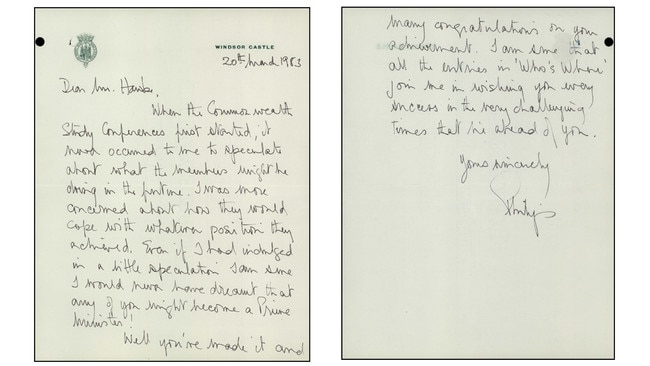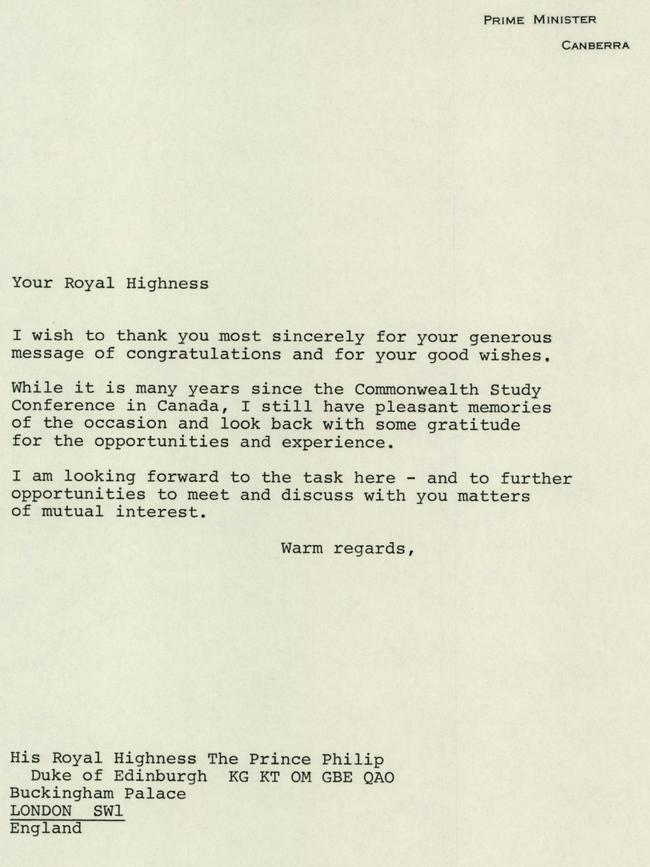How Prince Philip charmed Bob Hawke and others
Shortly after Bob Hawke led Labor to power in 1983, he received a personal letter from Prince Philip, who broke royal protocol to personally convey a warm message of congratulations.

Shortly after Bob Hawke led Labor to power and was sworn-in as prime minister on March 11, 1983, he received a personal letter from Prince Philip, Duke of Edinburgh, who broke royal protocol to personally convey a warm message of congratulations.
Hawke had attended the Duke of Edinburgh’s Commonwealth Study Conference in Canada in mid-1962 when he was Research Officer and Advocate for the ACTU. He met Philip in Canada and recalled their convivial conversation.
The letter — which has not been revealed before — shows the Prince to be positively enthusiastic and personally chuffed that Hawke, an alumnus of the prestigious Duke of Edinburgh Award program established by him and in his name, had fulfilled one of the core tenets of the awards — self-improvement and personal advancement in the service of others.
“Dear Mr Hawke,” Philip wrote by hand from Windsor Castle on March 20. “When the Commonwealth Study Conferences first started, it never occurred to me to speculate about what the members might be doing in the future. I was more concerned about how they would cope with whatever position they achieved.
“Even if I had indulged in a little speculation I am sure I would never have dreamt that any of you might become a prime minister! Well you’ve made it and many congratulations on your achievement. I am sure that all the entries in ‘Who’s Who’ join me in wishing you every success in the very challenging times that lie ahead of you.”
The letter, which forms part of Hawke’s personal papers at the National Archives of Australia, was made accessible just last year following a request by The Weekend Australian.
Hawke had won a scholarship to attend the Duke of Edinburgh’s Commonwealth Study Conference on Human Relations in Industry held in Canada from May to June 1962. He also travelled to the US and Europe in July and August, where he met government, business and union officials.
His focus of study was Britain’s decision to join the European Economic Community — the Common Market — and the trade and investment implications for Australia. Hawke also travelled to Malaya and Singapore for short periods of study and to lecture on industrial relations in Australia.

On April 19, Hawke finalised a handwritten letter of reply to Philip: “Your Royal Highness,” he began. “I wish to thank you most sincerely for your generous message of congratulations and for your good wishes.
“While it is many years since the Commonwealth Study Conference in Canada, I still have pleasant memories of the occasion and look back with some gratitude for the opportunities and experience.
“I am looking to the task here — and to further opportunities to meet and discuss with you matters of mutual interest.”
Philip was the first member of the British Royal family to contact Hawke after he became Prime Minister. This exchange of letters is just one of many between Philip and Australian prime ministers over more than 60 years. They reveal him to be personable, respectful, curious and wise.
When the Whitlam government came to power in December 1972, Philip thought he had found an administration like-minded on conservation issues. On April 2, 1973, Philip wrote to Gough Whitlam “on a personal basis” expressing his doubts about sufficient controls against the export of rare, wild native animal species.

He urged Whitlam to ban mining within the Myall Lakes region. He advocated the saving of Lake Pedder in Tasmania and said the state government “simply does not understand the point of conservation”. He was also concerned about the protection of the Kakadu National Park in the Northern Territory and conveyed these worries to Whitlam.
And, on May 2, 1973, Philip wrote to Whitlam again arguing that Lake Pedder should be saved by releasing the impounded water and restoring the lake.
Philip’s death at age 99 last week represents the beginning of the end of an extraordinary era. The second Elizabethan Age is now in its twilight reign. He was a loyal and devoted husband to Queen Elizabeth II and a critical support to her in her duties.
He was a remarkable man who devoted his life of public service as patron to many organisations, as an officer in the Royal Navy and as the longest-serving consort in British history. He left his own mark on the world and shaped the lives of many, including future prime ministers.
Troy Bramston is writing a biography of Bob Hawke, to be published by Penguin Random House




To join the conversation, please log in. Don't have an account? Register
Join the conversation, you are commenting as Logout